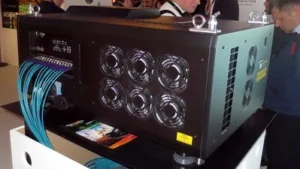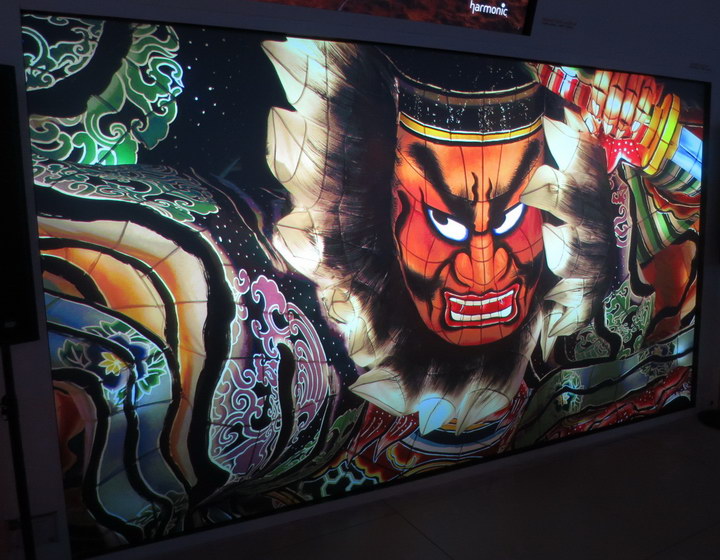 Image shown by the DP Insight Laser 8K Projector. (Credit: M. Brennesholtz)
Image shown by the DP Insight Laser 8K Projector. (Credit: M. Brennesholtz)
At ISE, the big news from Digital Projection (DP) was the new Insight Laser 8K projector. Strictly speaking, this isn’t an 8K projector, more properly it would be called UHD-2 resolution (7680 x 4320), but who’s counting? That’s still a lot of pixels from a single projector. The unit produces this resolution with a 3-chip DLP engine with 1.38” DarkChip DMD imagers, each with UHD (3840 x 2160) resolution. Pixel shift is then used to achieve the full UHD-2 resolution. The illumination system is blue laser plus yellow phosphor with 20,000 hours of life and the projector will produce 25,000 ANSI lumens.
Three different zoom lenses are available for the projector and together they cover the throw ratio range of 1.13:1 to 4.98:1. These lenses are the same lenses used in 4K projectors. I wonder if the lenses actually have a high enough MTF (resolution) at 8K to effectively show 8K pixels, since they were designed to only show 4K? I liked the image, however. Close examination of the screen did not show individual pixels, although noise that was presumably due to image processing was visible. In real life and from a normal viewing distance, with no pixel structure, good contrast and very good colors, the image appeared almost 3D. For me, at least, really good blacks and really good reds always makes an image appear 3D.
 Digital Projection Insight Laser 8K Projector (Credit: M. Brennesholtz)
Digital Projection Insight Laser 8K Projector (Credit: M. Brennesholtz)
The laser hazard sticker on the projector displayed at ISE actually identifies the projector as an Insight Dual Laser 4K projector. Presumably, the optical insides of the projector are similar to the Dual Laser 4K, with the addition of the pixel shift mechanism. However, the DP rep told me the projector had a single laser source, unlike the Insight Dual Laser 4K projector. The label identifies it, not surprisingly, as a Risk Group 3 projector. (See below for a discussion of projector Risk Groups.)
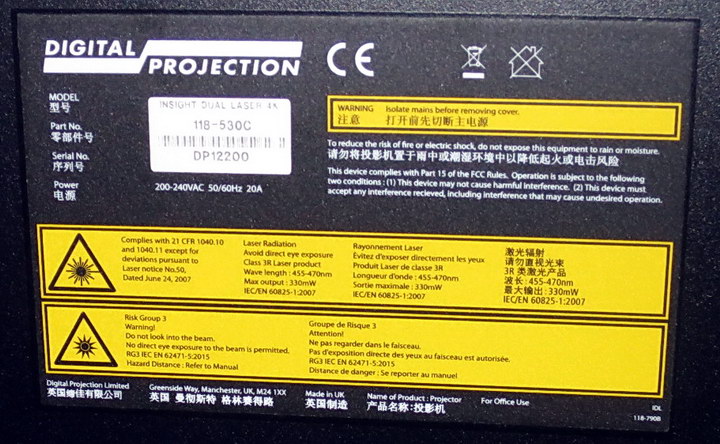 Laser hazard label on the Insight Laser 8K projector. (Credit: M. Brennesholtz)
Laser hazard label on the Insight Laser 8K projector. (Credit: M. Brennesholtz)
While the projector may have the same basic optics, the electronics must be significantly modified to accommodate 8K/UHD-2 video input. The projector has 3G-SDI x 16 and 12G-SDI x 4 inputs. Future planned inputs include HDMI x 4 and 12G-SDI x 8. In the photo, it can be seen that all 16 of the 3G-SDI inputs are connected to provide video to the projector. Currently the projector will show content up to 60FPS but when the new inputs are implemented it will be able to show 8K/UHD-2 120FPS video.
According to the DP rep, the price on this projector will be $400,000 and it will ship in Q4. He added that by Wednesday of ISE, there had already been several serious enquiries about the use of the projector as a home theater projector. He also told me that other DP projectors have been “refreshed” since the last ISE, but there have been no other projector product introductions.
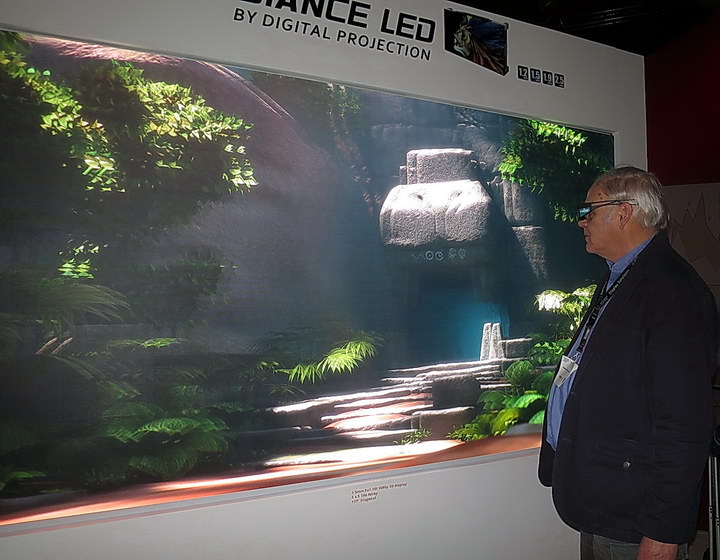 Meko’s Matt Brennesholtz watches 3D content on the DP Radiance LED videowall at ISE. (Credit: M. Brennesholtz)
Meko’s Matt Brennesholtz watches 3D content on the DP Radiance LED videowall at ISE. (Credit: M. Brennesholtz)
DP was also showing a Digital Projection-branded LED videowall at ISE, sourced from Delta. This Radiance LED videowall will be available in 1.2, 1.5. 1.9 and 2.5mm pitches. The unit being demonstrated had a 1.5mm pitch, Full HD (1920 x 1080) resolution, a 5 x 5 tile array and a 137” diagonal. They were showing 3D content on the display using active glasses in the DP booth.
![]() DP Side-by-side comparison of 1.2, 1.5, 1.9 and 2.5mm pixel pitches. (Credit: M. Brennesholtz)
DP Side-by-side comparison of 1.2, 1.5, 1.9 and 2.5mm pixel pitches. (Credit: M. Brennesholtz)
DP had a side-by-side comparison of all four pixel pitches available in the Radiance LED videowall system which was a useful demo for ISE attendees who weren’t sure of the pixel pitch needed for their application.
Digital Projection announced at ISE that it had become a “Delta Associate Company.” I was told, not by a DP or Delta representative, this meant that Delta now owns 40% of DP.
Photobiological Risk Groups
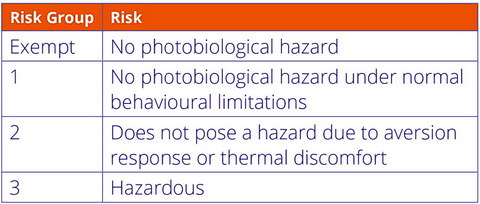 Projector risk groups defined by IEC BS EN 62471-5:2015. (Credit: Digital Projection)
Projector risk groups defined by IEC BS EN 62471-5:2015. (Credit: Digital Projection)
There is a relatively new standard (IEC BS EN 62471-5:2015) that covers the photobiological effects of lamps and lamps systems in projectors. While the title of the standard mentions “lamp and lamp systems,” The standard really addresses the power density out of the projection lens, regardless of whether the projector uses a lamp, laser-phosphor or RGB laser illumination.
I was not familiar with this standard or Risk Groups and found on-line a Digital Projection document that give a simple explanation of the standard along with the risk group categorization for a variety of DP projectors. This standard defines Risk Groups 1, 2 and 3 for projection systems that applies to all projectors, including both lamp and laser based, that are sold in the EU. There is no direct relationship between ‘Laser Class’ and ‘Risk Group’ and a projector can be laser class 1 and still be in Risk Group 3. Another concept in this standard is “hazard distance.” If people are prevented from approaching within the hazard distance of a risk group 3 projector, the projector installation is reduced to Risk Group 2.
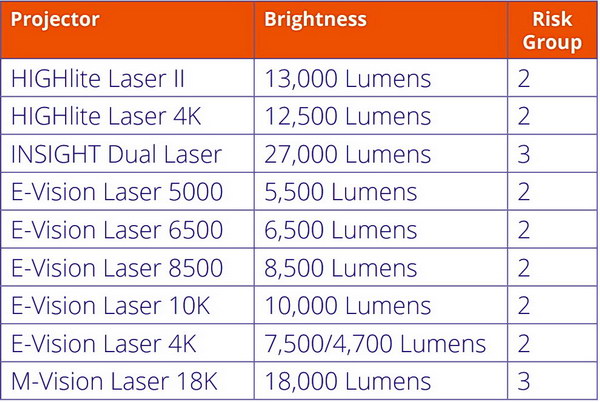 Risk Group ratings for selected Digital Projection projectors. (Credit: Digital Projection)
Risk Group ratings for selected Digital Projection projectors. (Credit: Digital Projection)
Part of the Digital Projection article gave the Risk Group rating for its projectors, as shown in the table above. At DP, you can get a projector up to 13,000 lumens and still be in Risk Group 2. If you need 18,000 lumens, however, you need to be prepared to deal with a Risk Group 3 projector. Typically, the Risk Group category would be marked on a projector. In the sample projector label, the English version of the Risk Group warning is highlighted in the red rectangle.
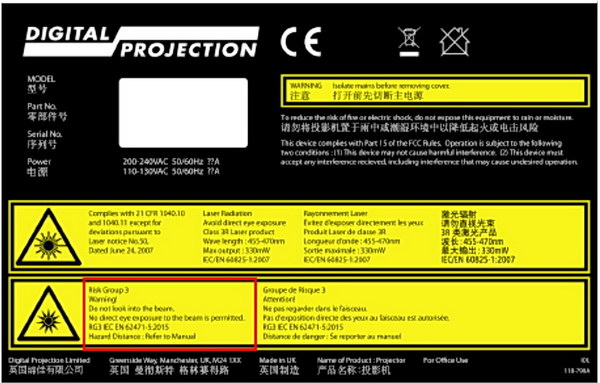 Risk Group information is included on a sample DP projector label. (Credit: Digital Projection)
Risk Group information is included on a sample DP projector label. (Credit: Digital Projection)
Digital Projection gave some comparison power density figures:
- 27,000 lumen projector = radiance value of 2 MW/m²-sr
- The visible light of the Sun = 7 MW/m²-sr
- 5 mW laser pointer = 70 MW/m²-sr
The company commented: “The Risk Group rating is provided as a guide for system designers, integrators, and users to have safe guidelines in using our brightest projector products. Although one should always stay within the safety guidelines, our brightest projectors are still safer than staring at the sun or directly at a laser pointer.” – Matthew Brennesholtz

